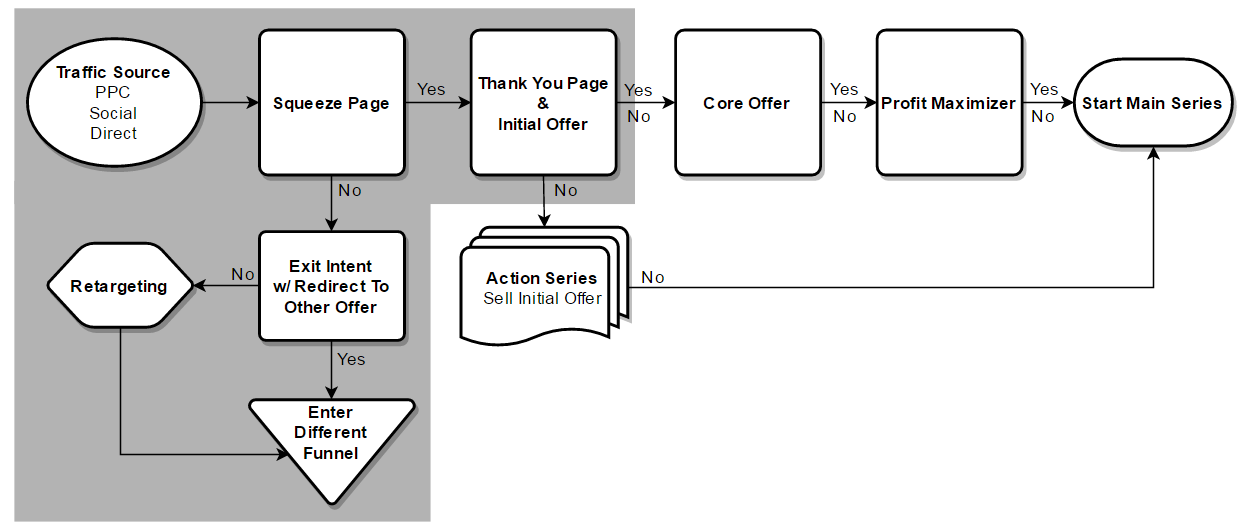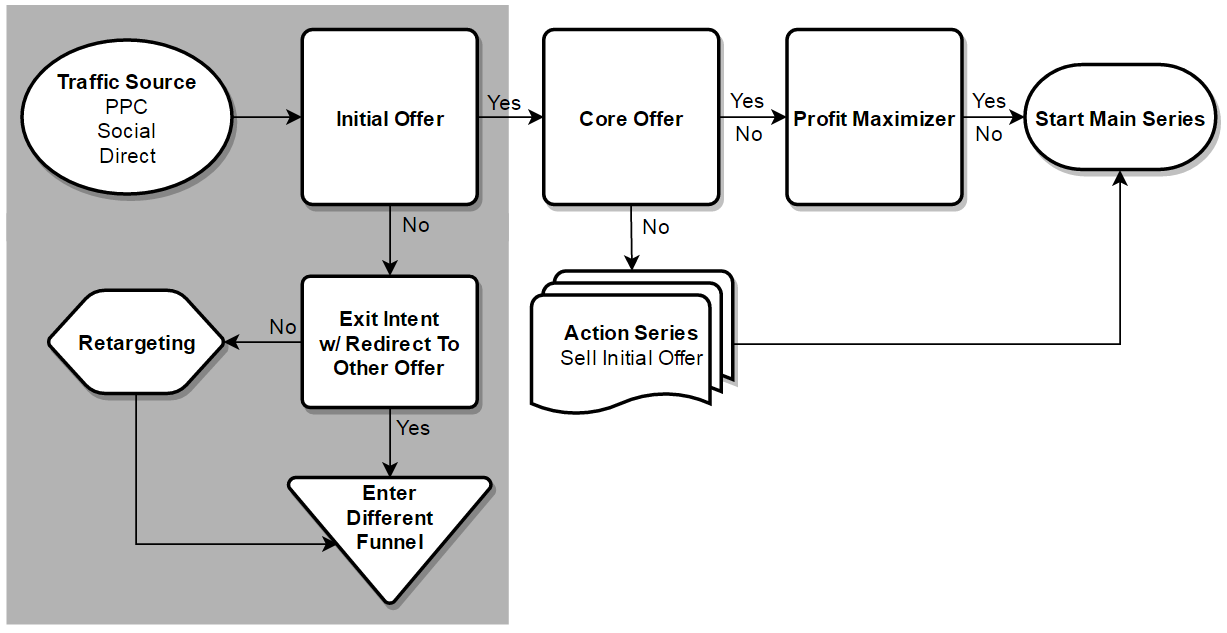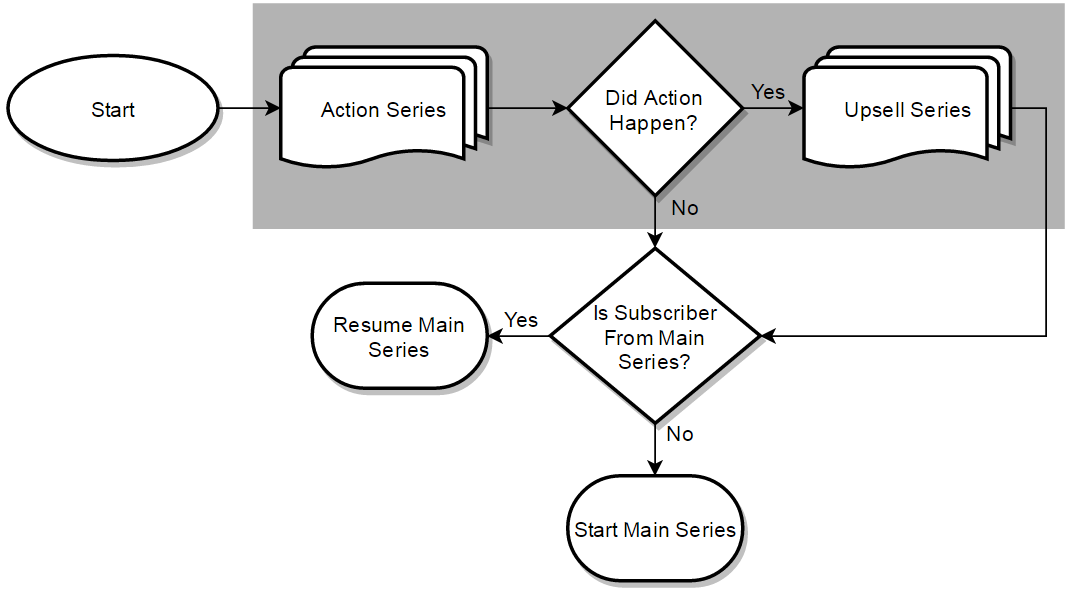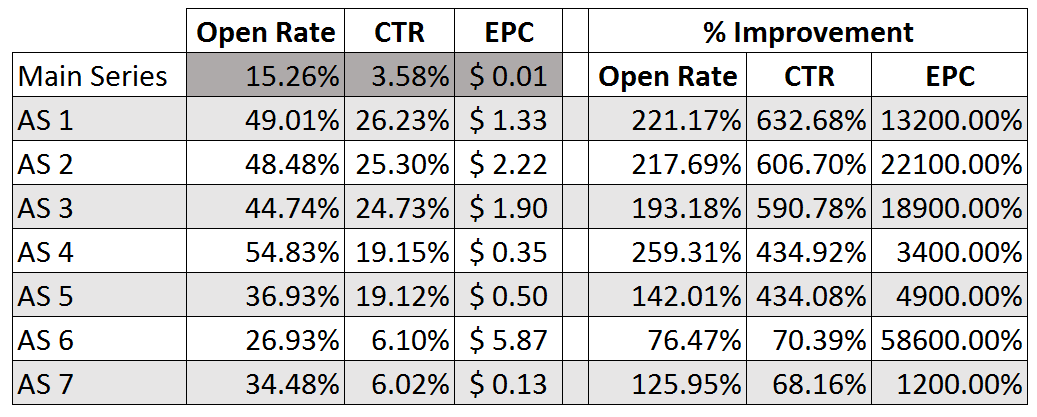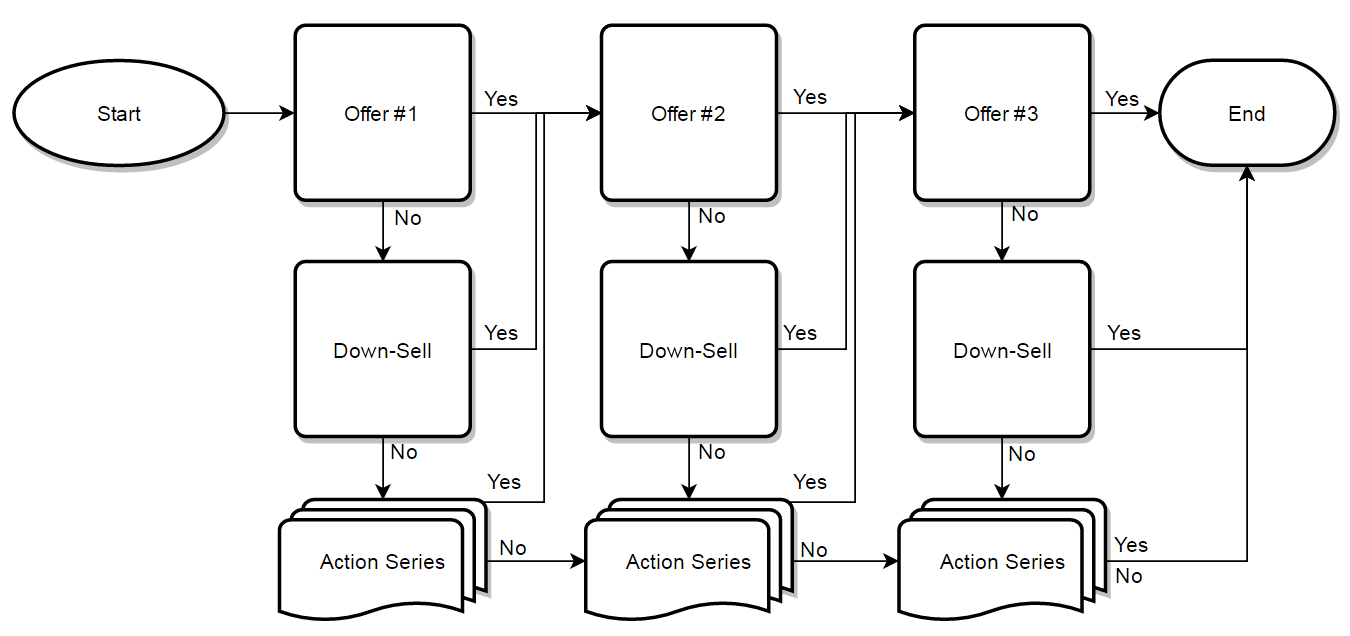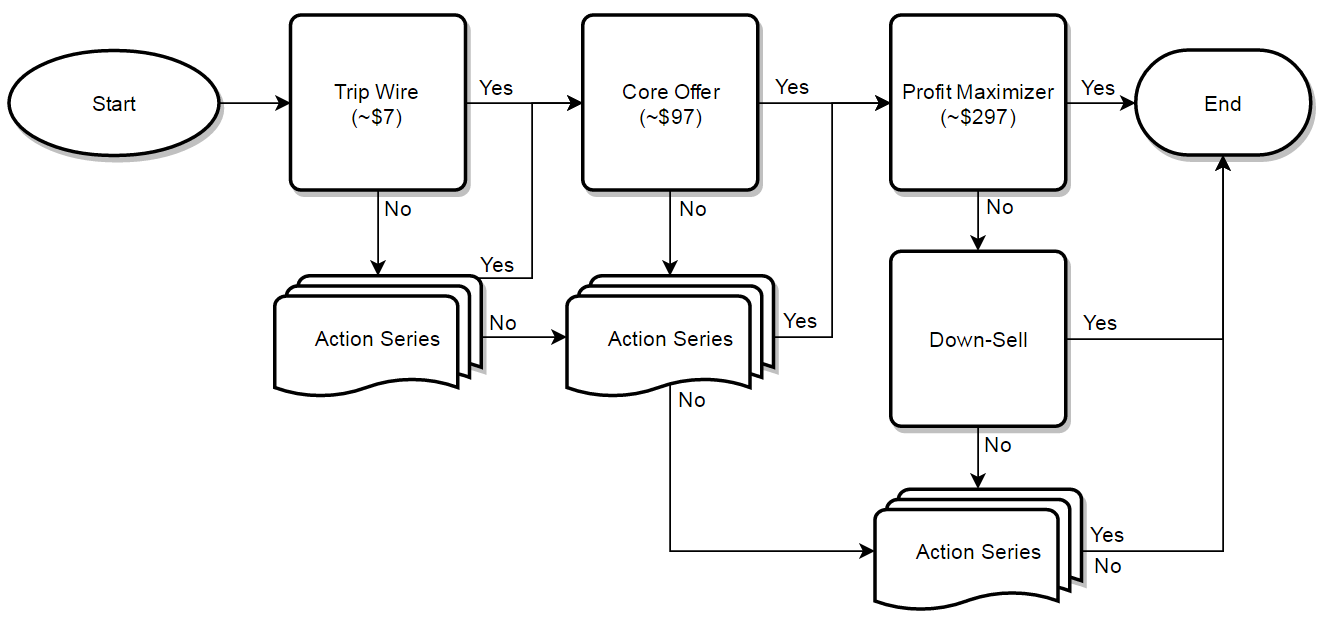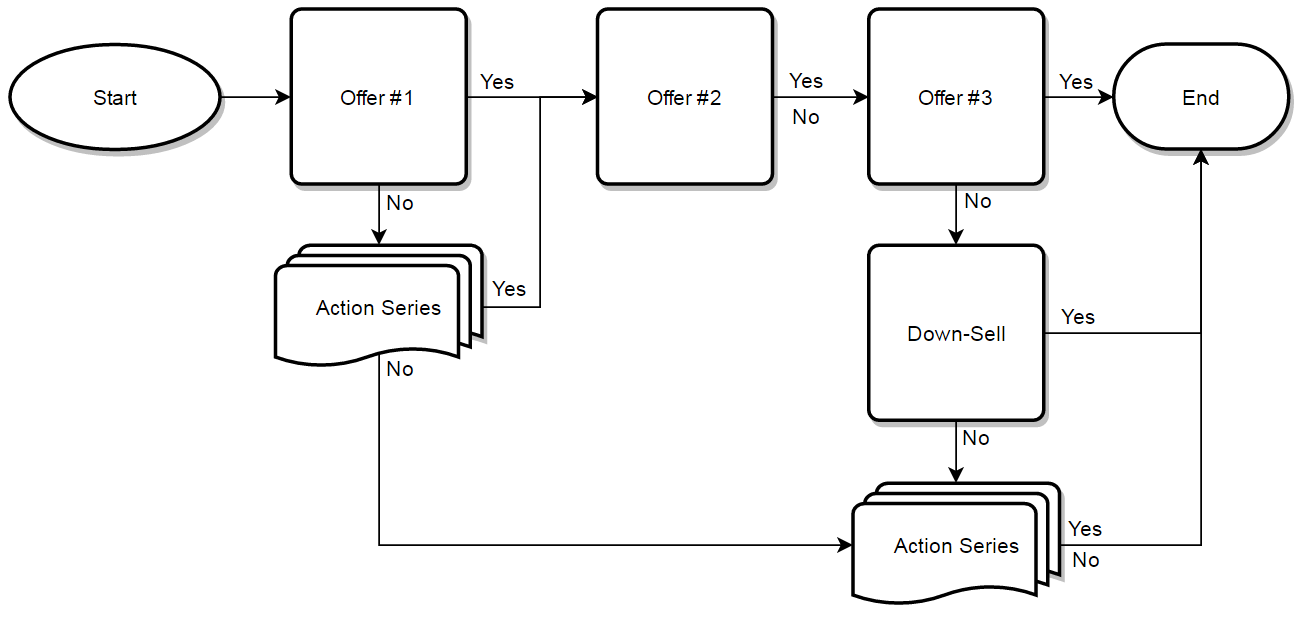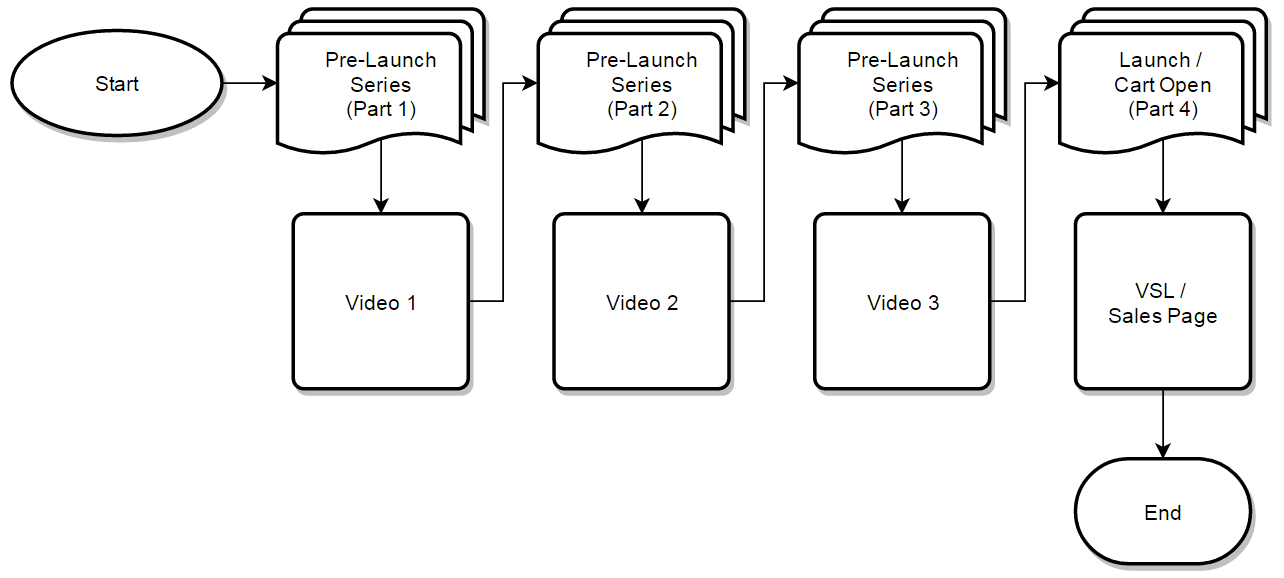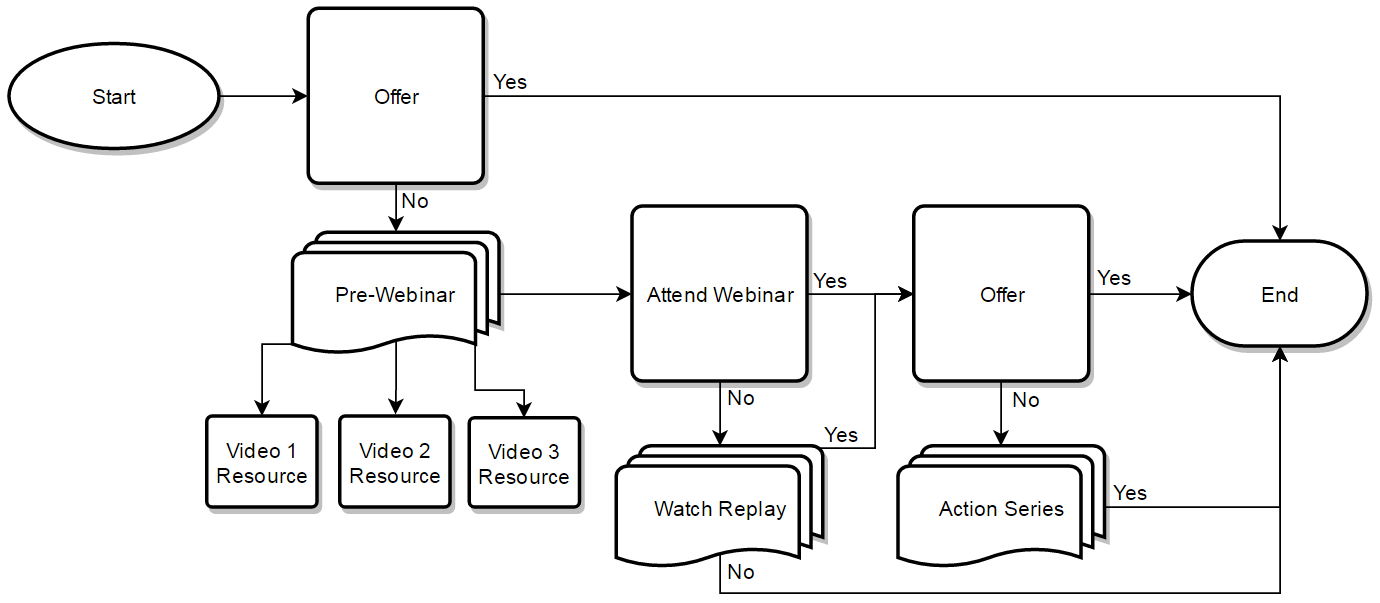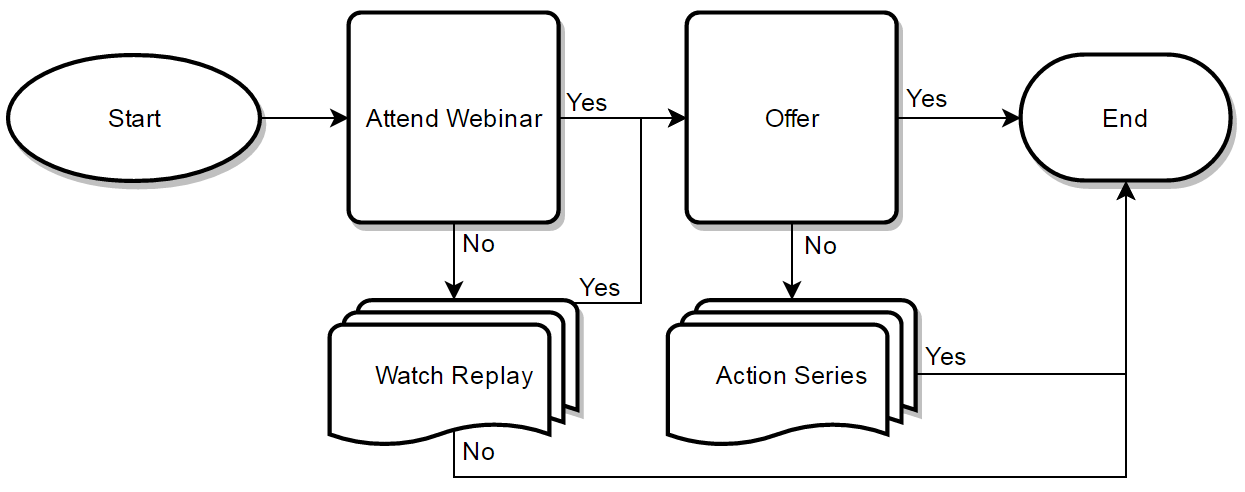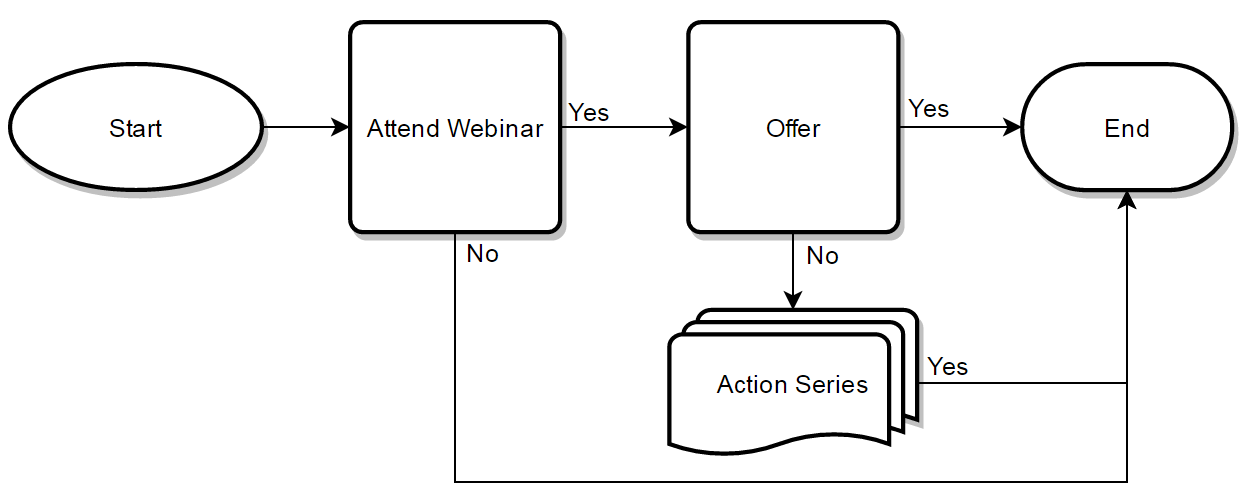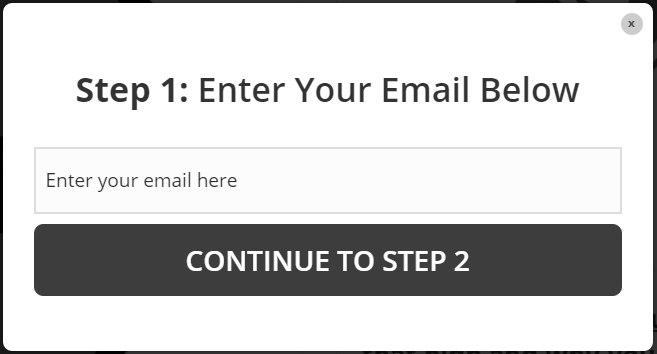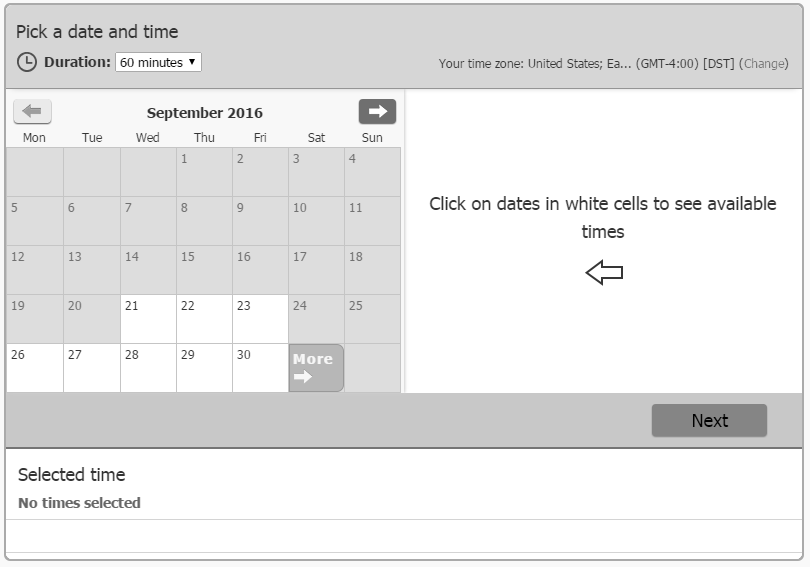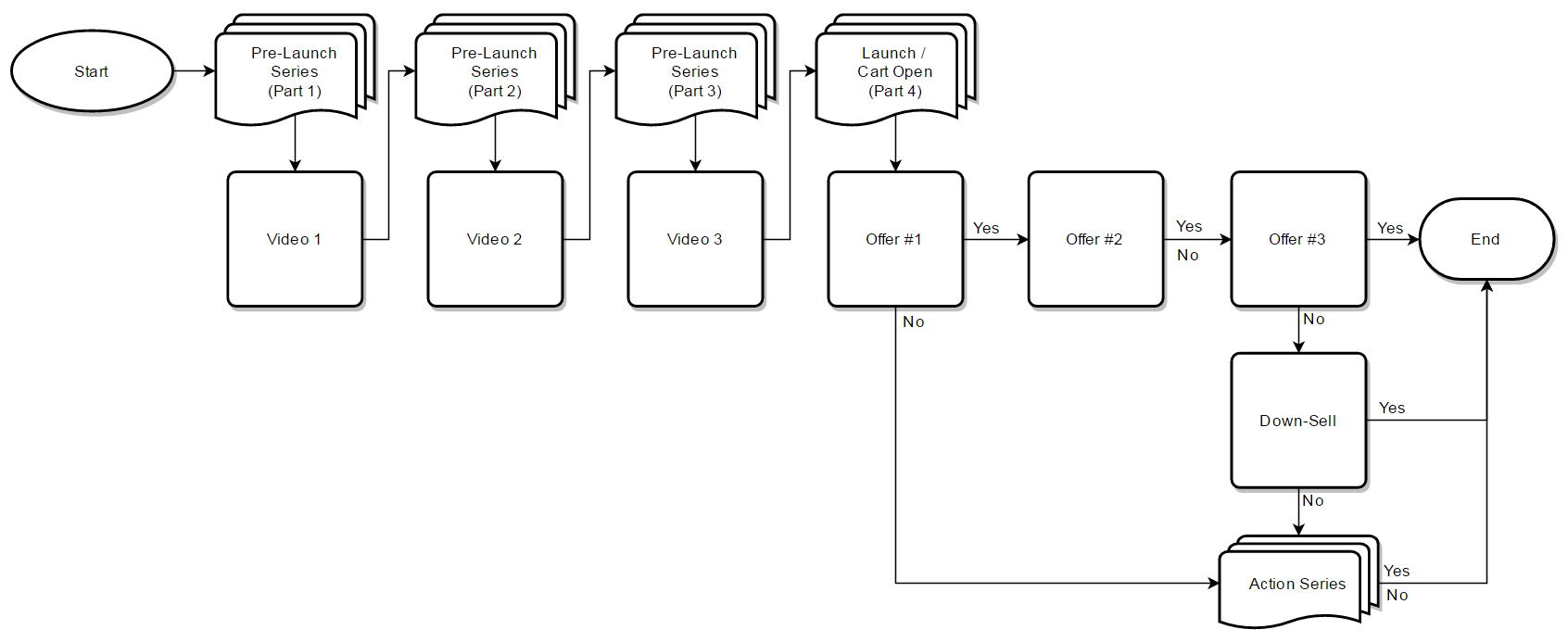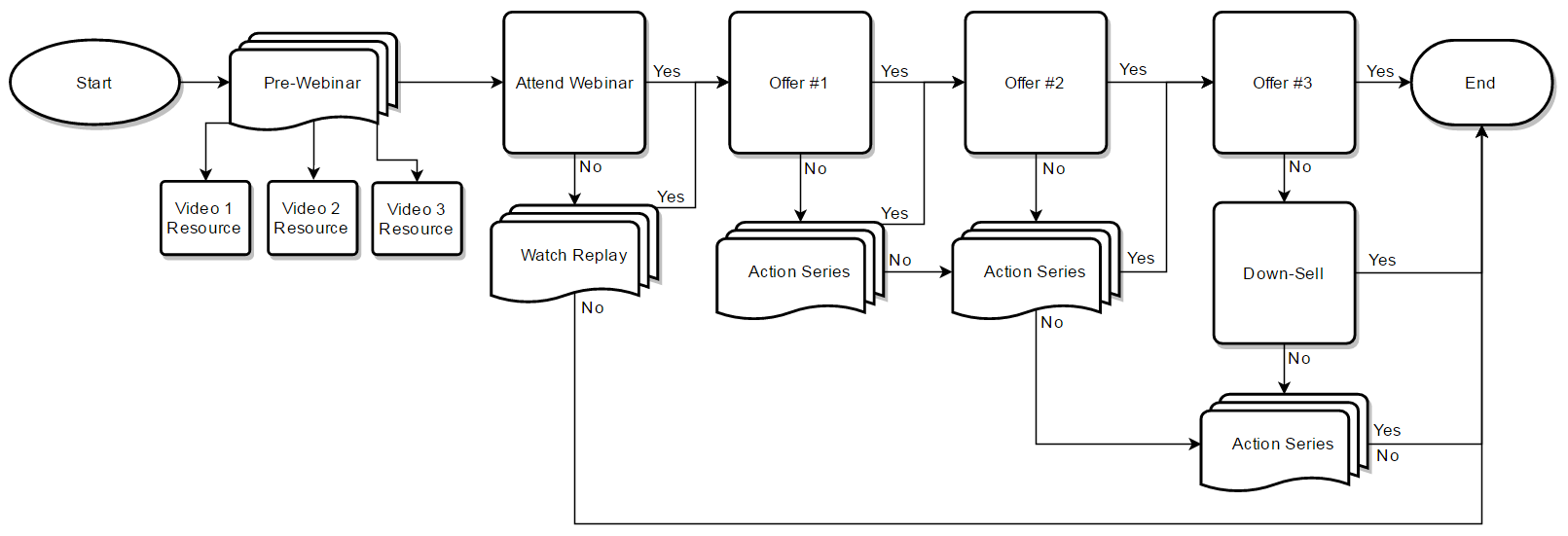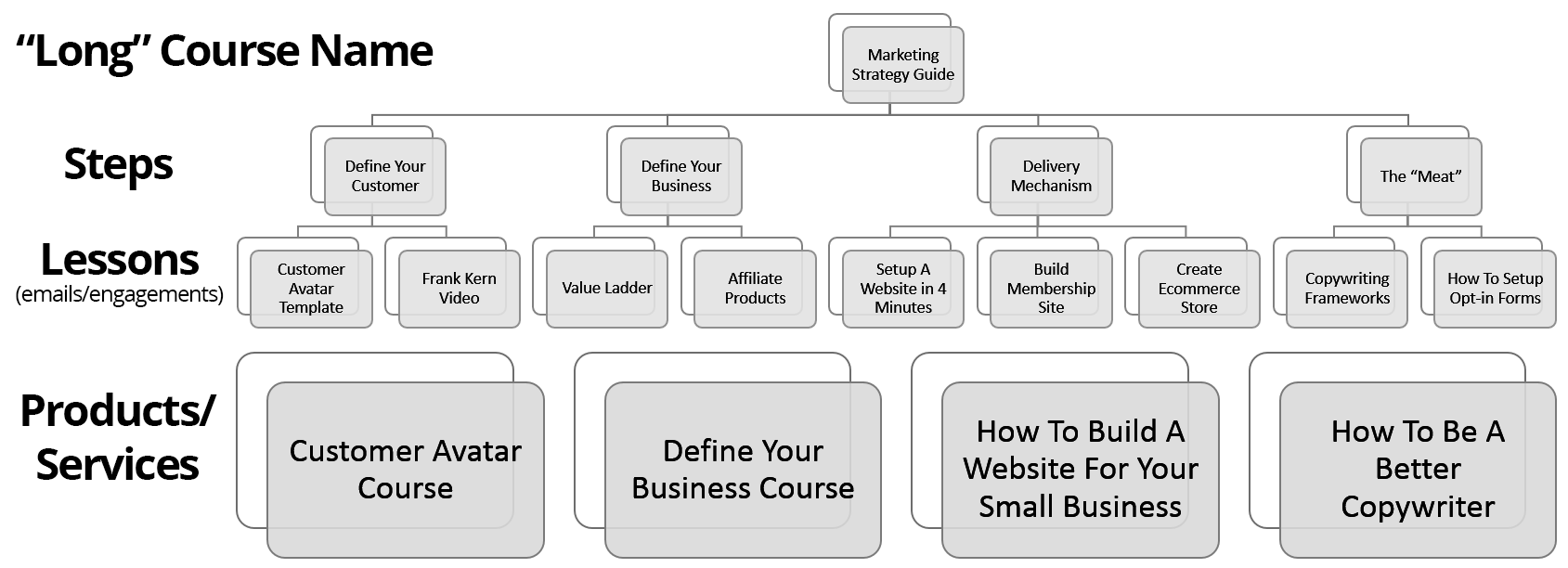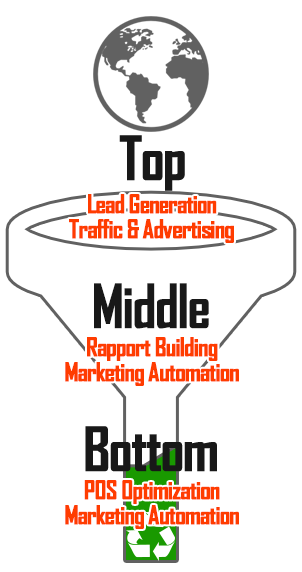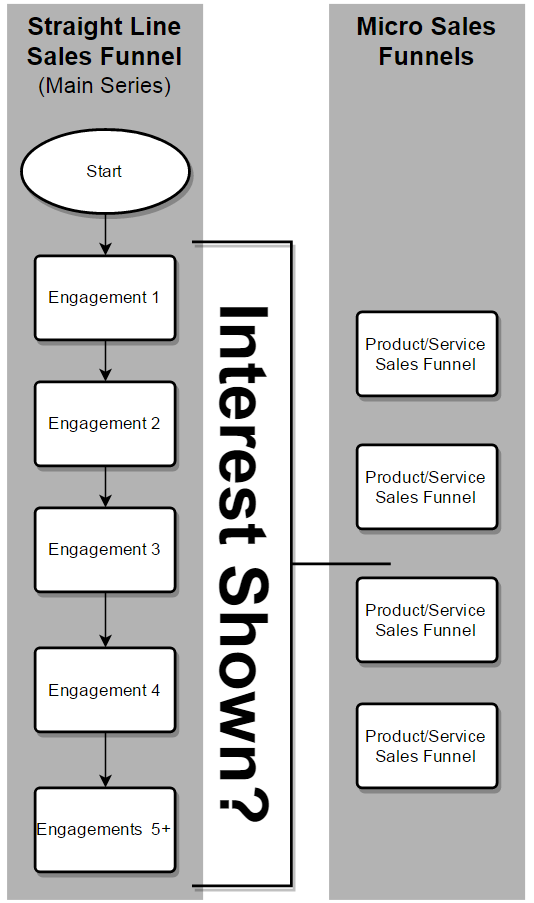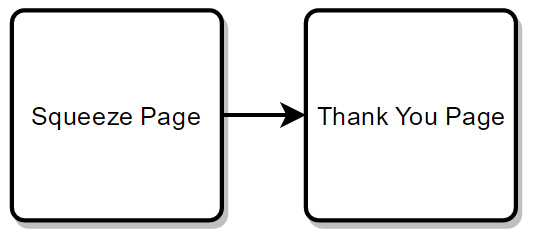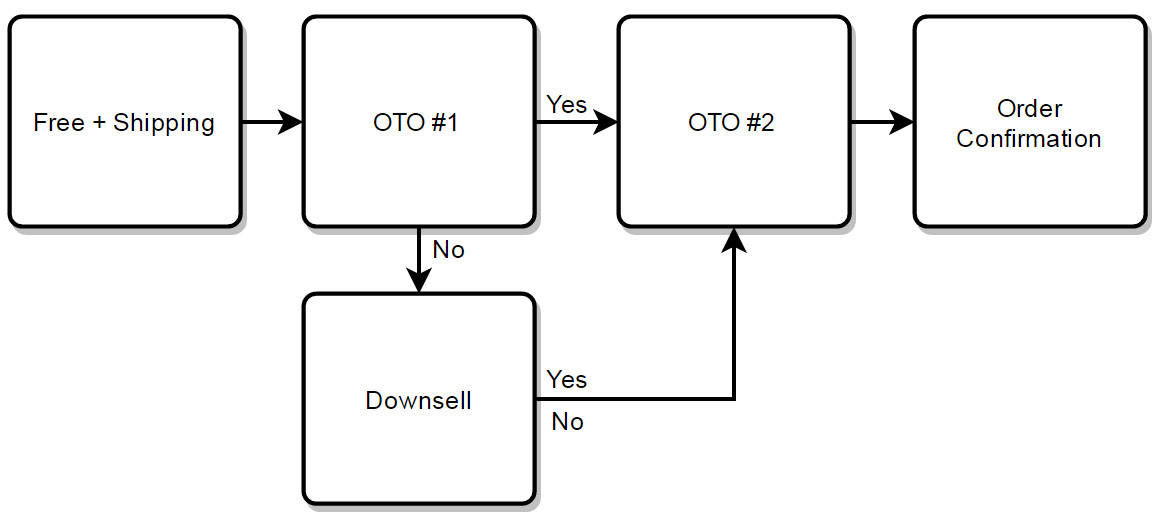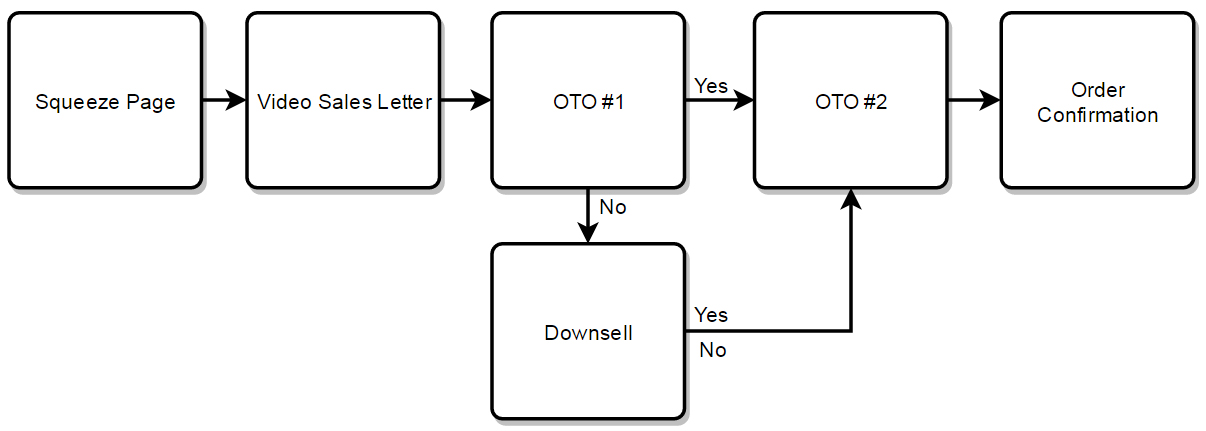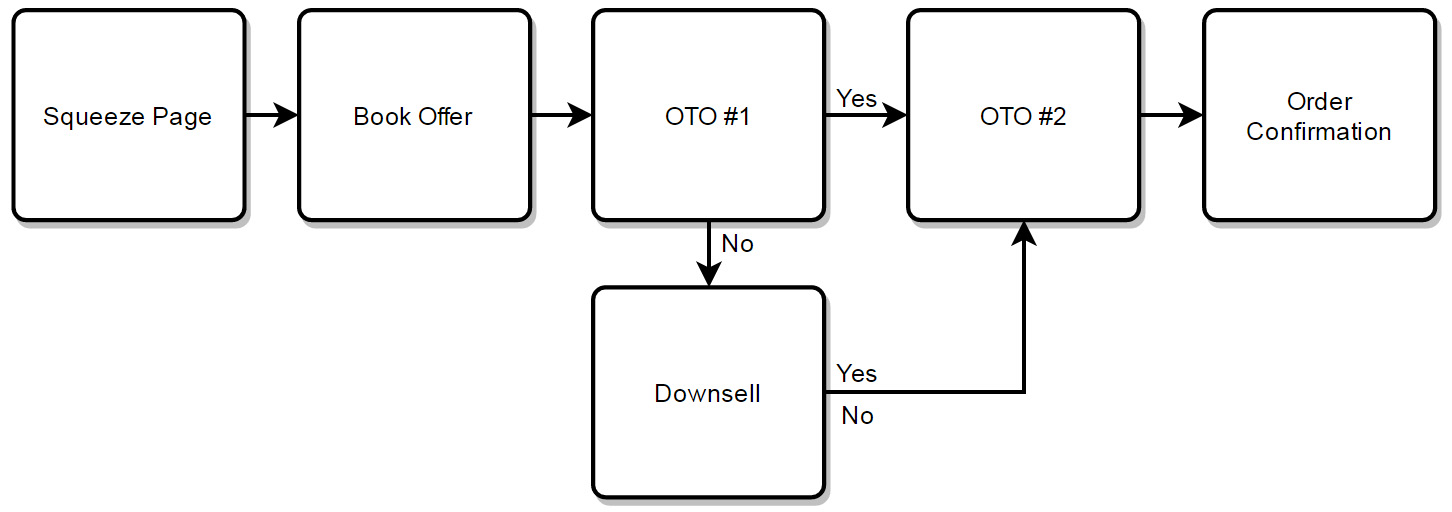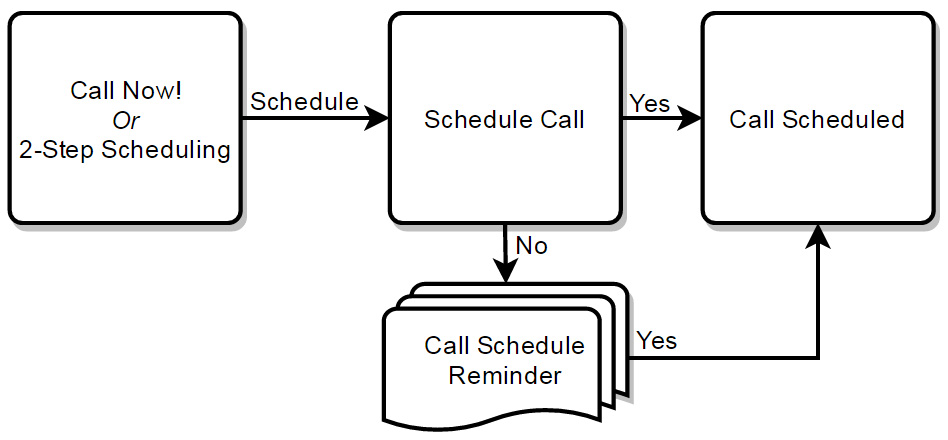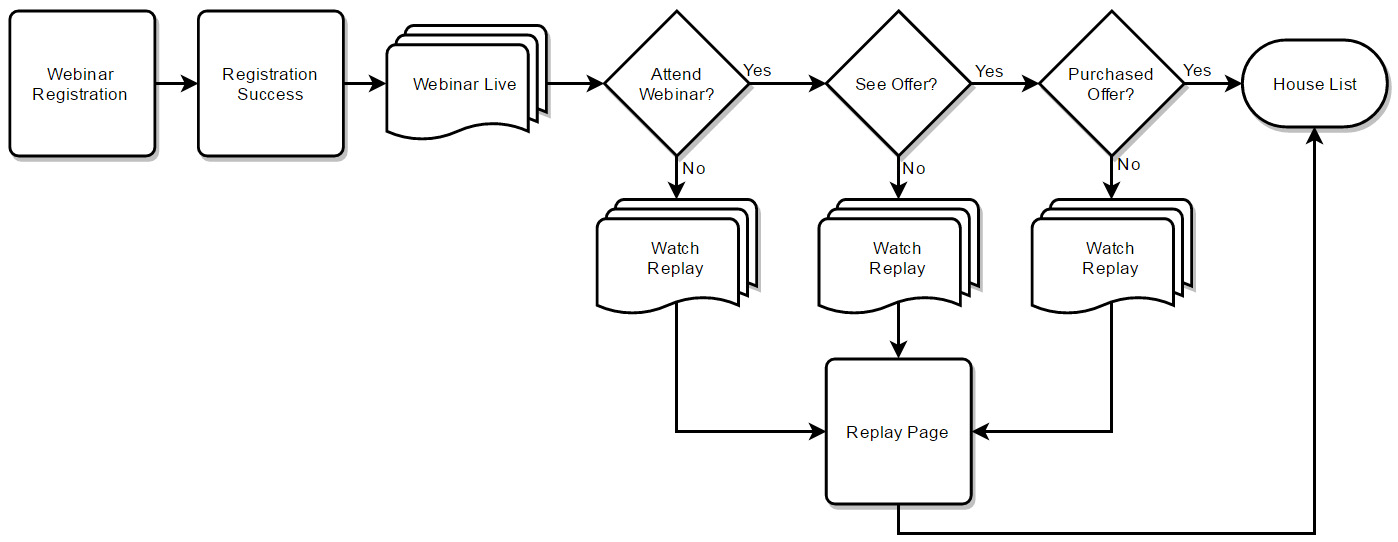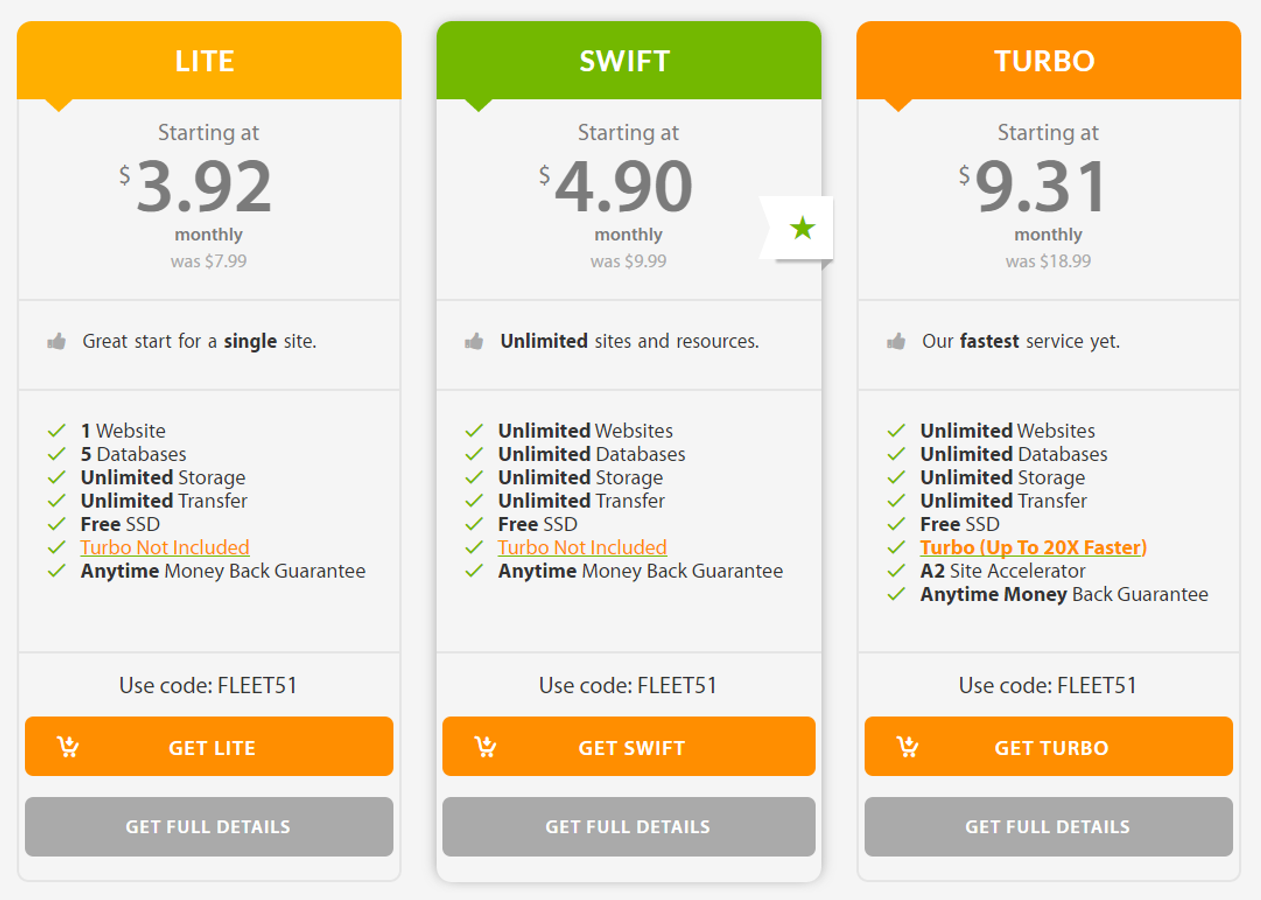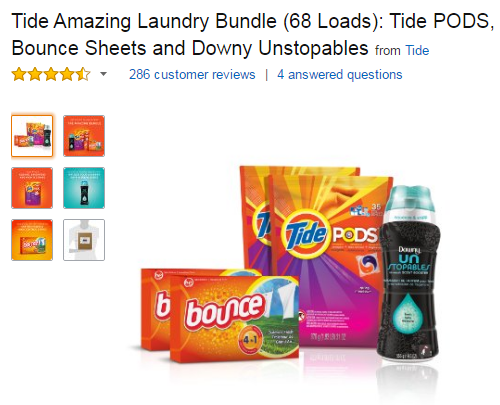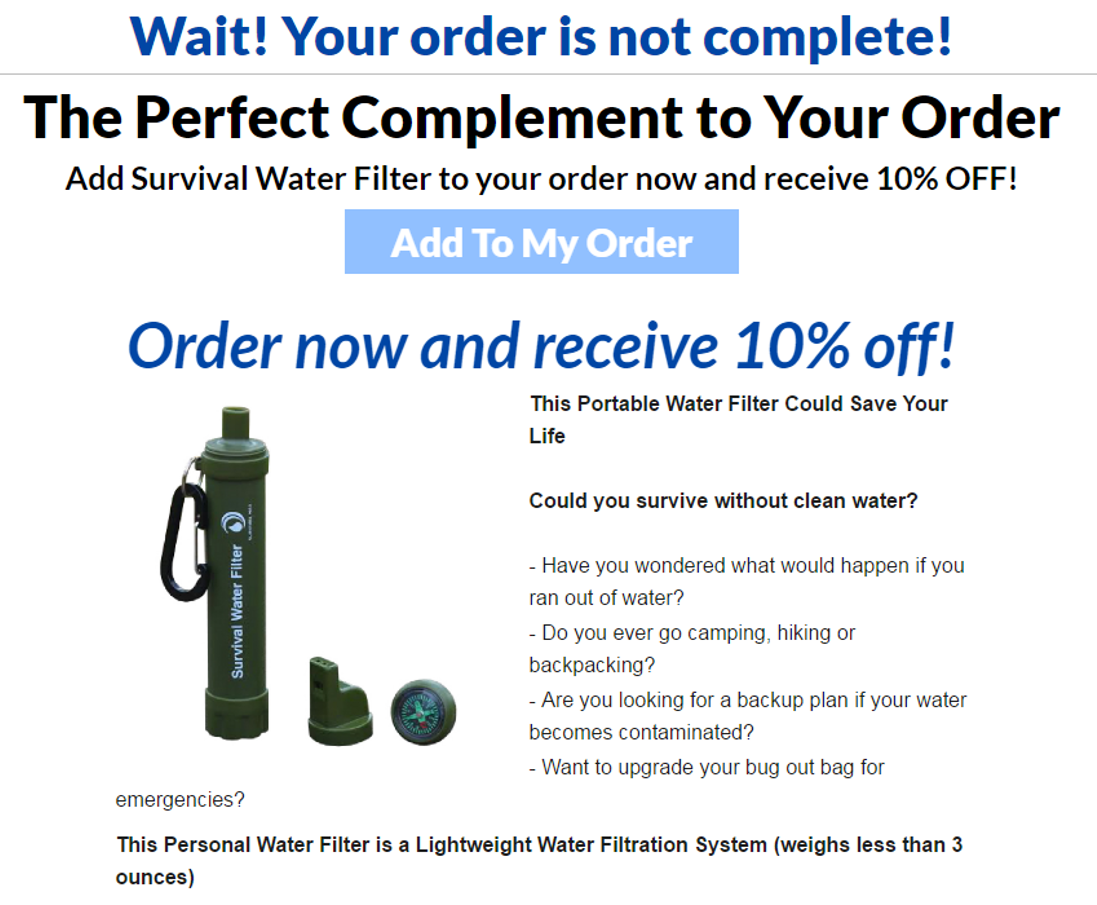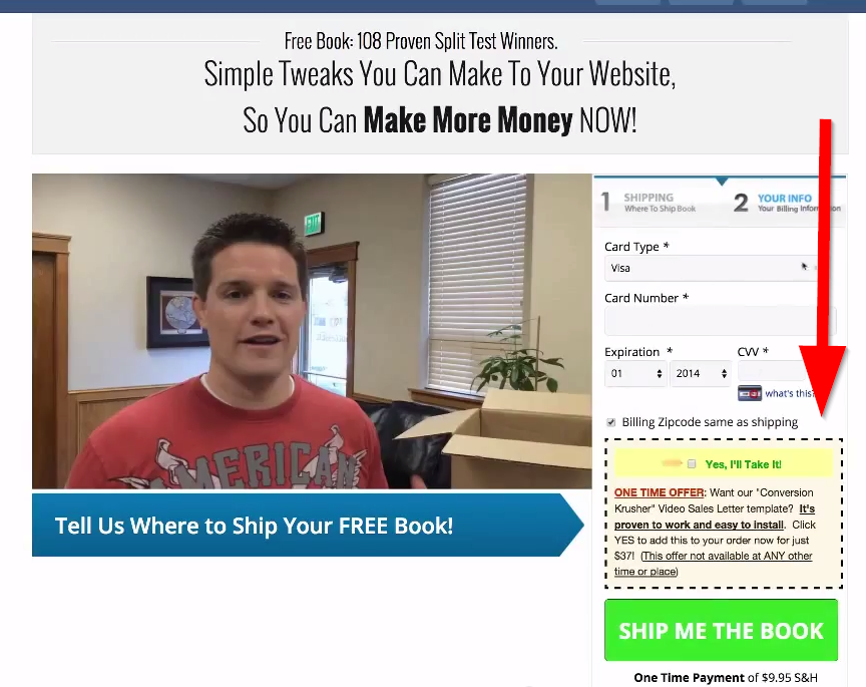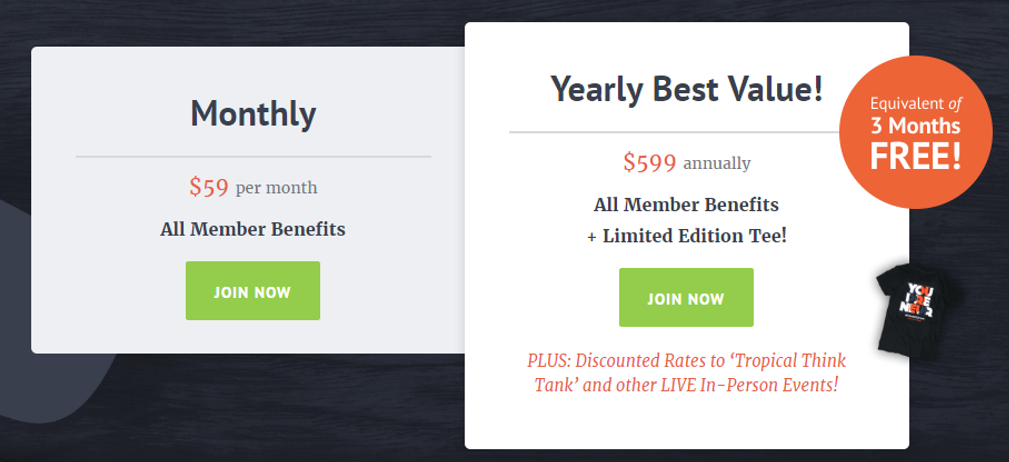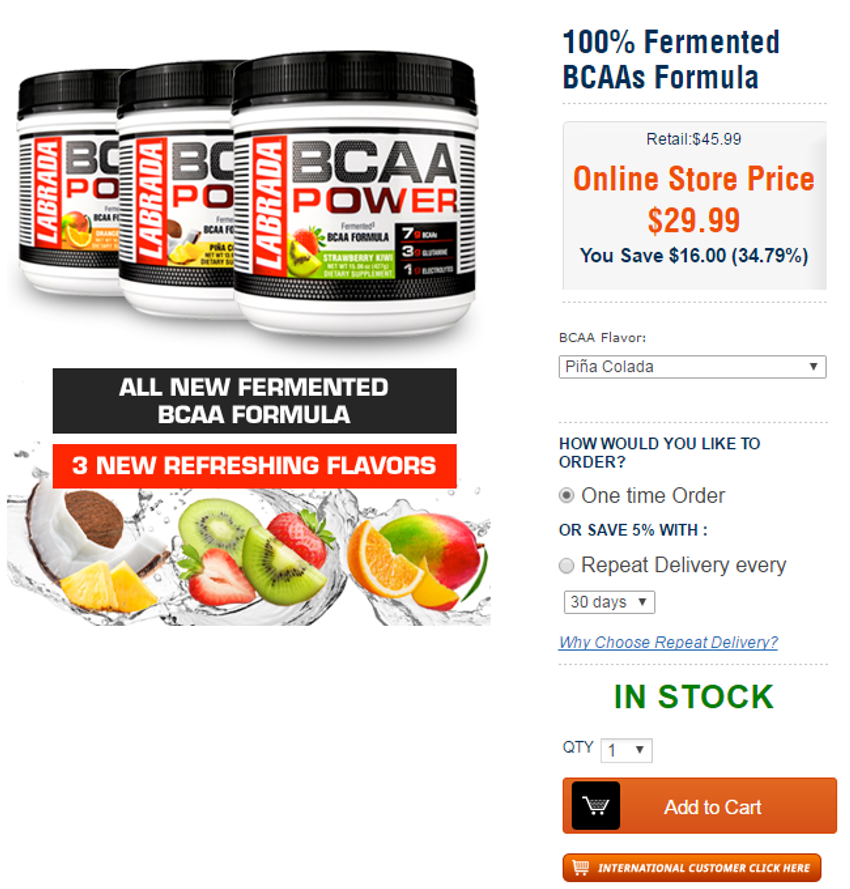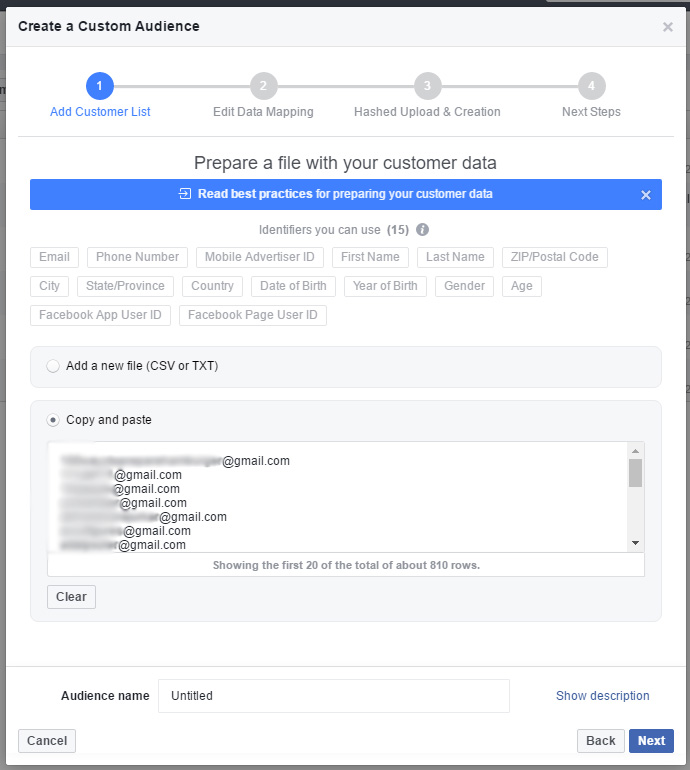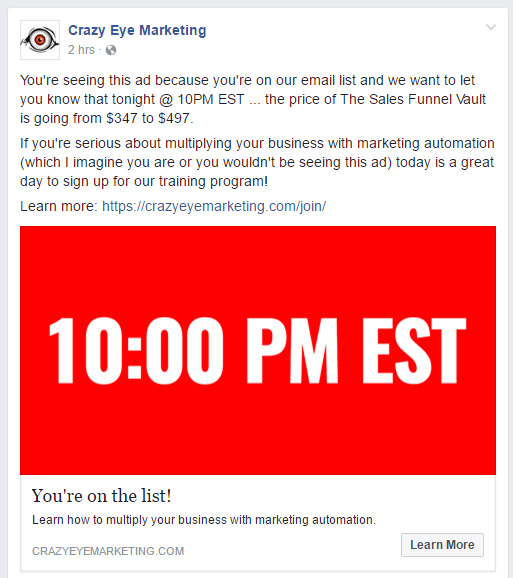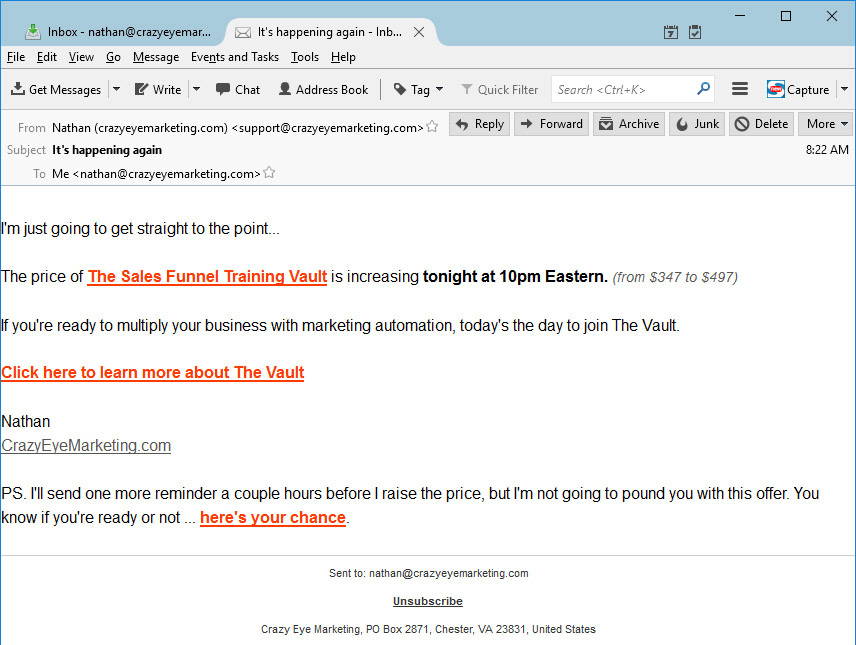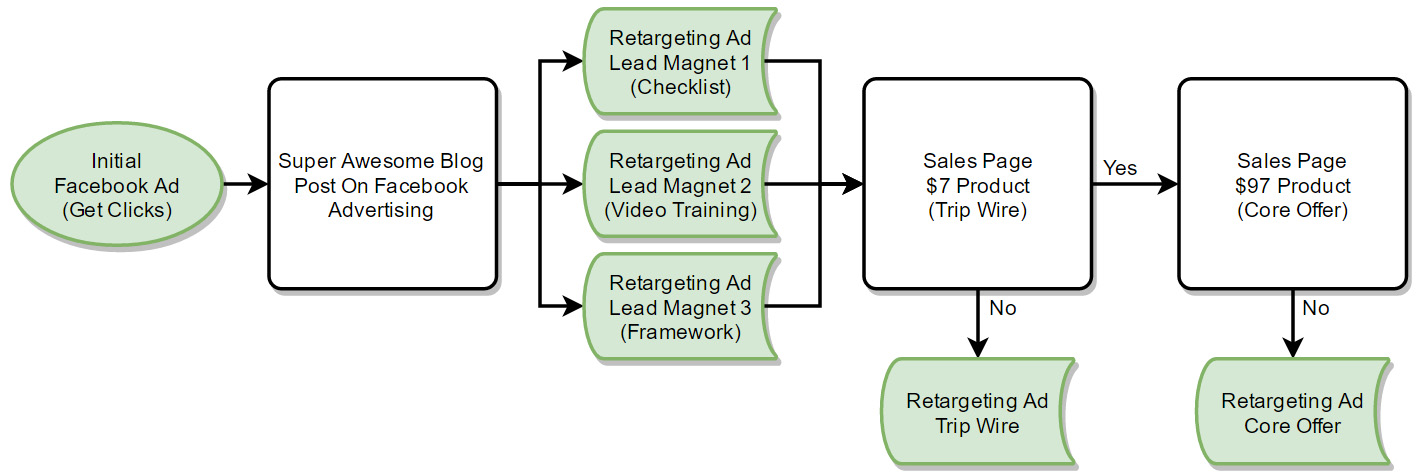What Kind Of Sales Funnel Should I Build?
I get a lot of questions.
Some are very specific, like – “What button should I click?”
While others are more general, such as…
- Do I need a sales funnel?
- Will a sales funnel work for my business?
- What sales funnel should I build?
This post is designed to help answer those more general questions.
First, What Is A Sales Funnel?
I'm not going to go into too much detail here because I write about this extensively on this site. However, I wanted to lay some groundwork to ensure we're all on the same page.
Simply put, a sales funnel is the path through which you take your ideal customer:
- Introduce yourself
- Build a relationship
- Convince them to buy something from you
- Keep them happy and convince them to buy more from you
That's it.
For those who like pretty pictures, here's an illustration of what I've outlined above…
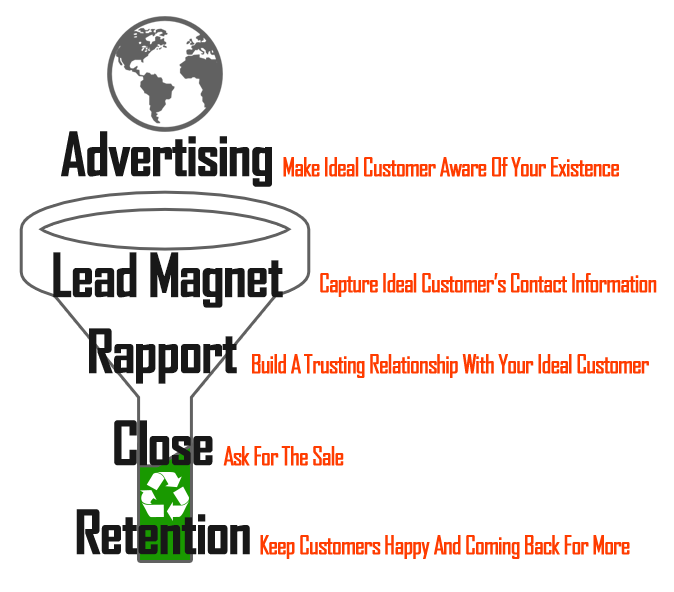
Of course, there are many strategies for doing this…
The one I use is called The Interest Driven Sales Funnel Strategy.
The Interest Driven Sales Funnel Strategy works by breaking the sales funnel into two levels:
- Macro
- Micro
At the Macro level, we're reaching out to our audience, trying to figure out what they're interested in, and once we have an idea of what they like… we try to sell them something.
For selling, we use Micro Sales Funnels. These are sales funnels designed to sell a specific product or service.
That's as deep as I'm going to go into Macro vs. Micro sales funnels in this post…
Just remember…
- Macro = bring people in and gauge interest
- Micro = sell products/services the person has shown interest in
Don't Forget The Big Picture… The Macro Level Is Important!
The rest of this post is going to be about Micro Sales Funnels.
Micro sales funnels are cool! You can make pretty diagrams of them and there are a bunch of tools for building them…
However, I brought up the Macro level because it's very important and the key to success.
How you bring people into your business, establish your relationship with them, and gauge their interests is critically important.
Please don't forget the Macro level when building your Micro Sales Funnels because if you do, your Micro sales funnels will suffer!
Capiche?
What Micro Sales Funnel Should I Build?
#1 Goal Of This Exercise
Here's the deal…
The #1 goal of this exercise is to ultimately build one successful funnel.
Do not go out and build 10 mediocre or terrible funnels simply because you have 10 products.
You build one funnel and get that thing working.
What do I mean by “working”?
It breaks even. Ie, your net profit is greater than or equal to $0. (Revenue – Ad Spend – Cost Of Goods – Fulfillment/Shipping – Time – Credit Card Fees – Every Other Expense To Get The Sale >= $0)
If you can get a new customer for $0… everything else you sell them is icing on the cake.
The easiest way to do this? Sell a product or service you already know sells well.
Unless you have a bunch of working funnels already, it's not the time to build funnels to launch random, unproven products.
So please, get that one working funnel FIRST; then, you can build another, and another, and another…
The Sales Funnel Flowchart
I love a good flowchart.
Answer a few simple questions and BOOM, you have your answer to a complex question!
Here's a flowchart to help you figure out what type of Micro Sales Funnel you should build:
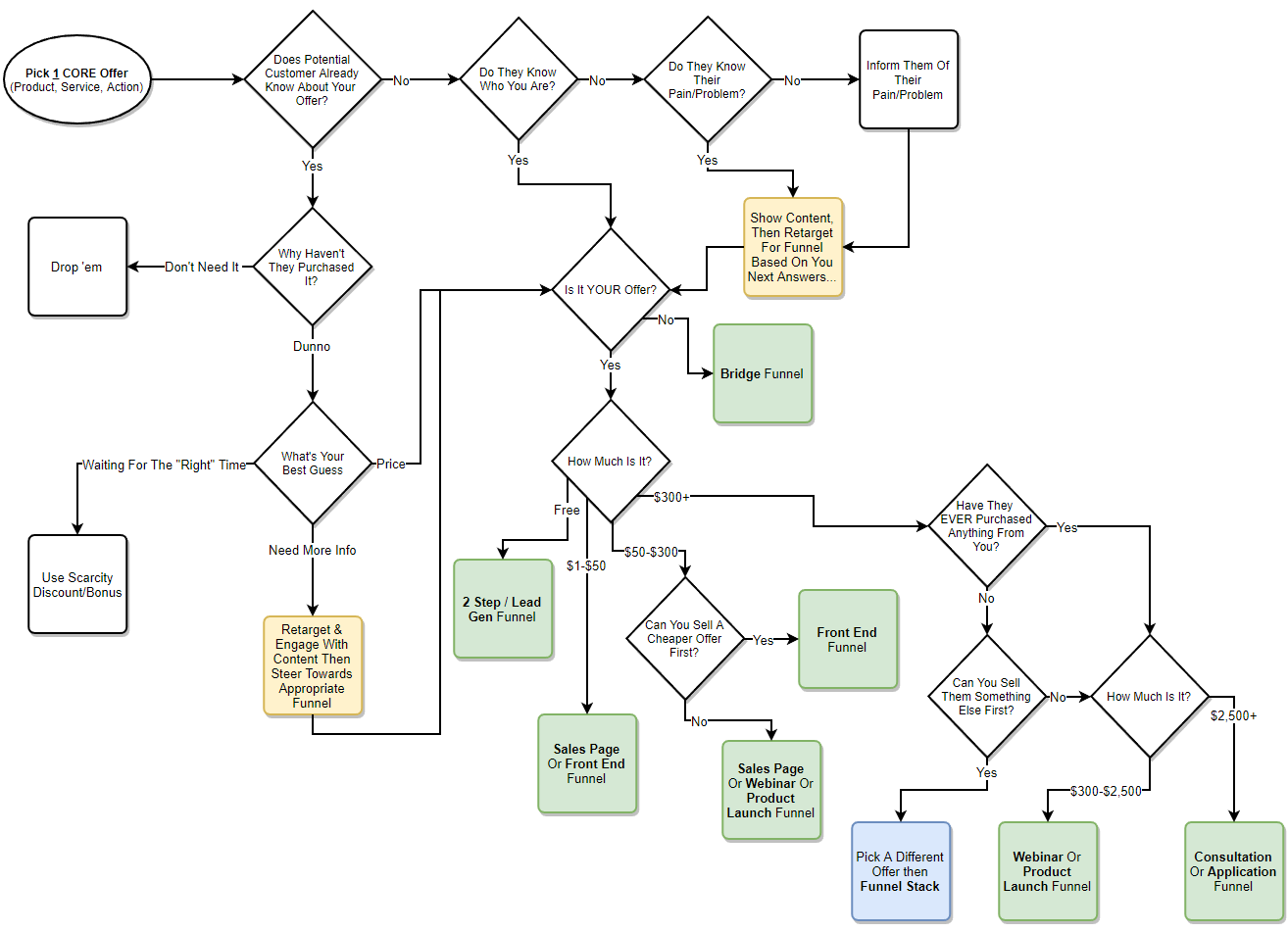
This flowchart should be pretty self-explanatory, but if you have any questions, please leave a comment below.
Now, I want to quickly hit on the starting point…
Pick 1 CORE Offer
Just ONE!
What is the one thing you want to sell or have someone do? Don't sit there and envision your entire funnel already, or decided you want a “webinar” funnel…
Pick 1 offer:
- I want to sell my $197 course on underwater basket weaving
- I want to sell my $9.95 flashlight
- I want to sell this $47 affiliate product
- I want someone to buy my $3,000 web design package
- I want someone to visit my business to claim their free teeth cleaning
Got your 1 core offer?
Great!
Now, run it through the flowchart.
Show Content And Retarget

Oftentimes, people simply don't know enough about you, your offer, their pain/problem, etc.
In this case, you need to show them more content like blog posts and videos via ads, emails, social media posts, etc.
Note: The content you show them should link to your Micro Sales Funnel so the individual can easily move on to the next step.
Finally, you will want to retarget these individuals in order to bring them to your Micro Sales Funnel.
- Related Article: How To Use Retargeting To Generate Sales
2 Step / Lead Gen Funnel
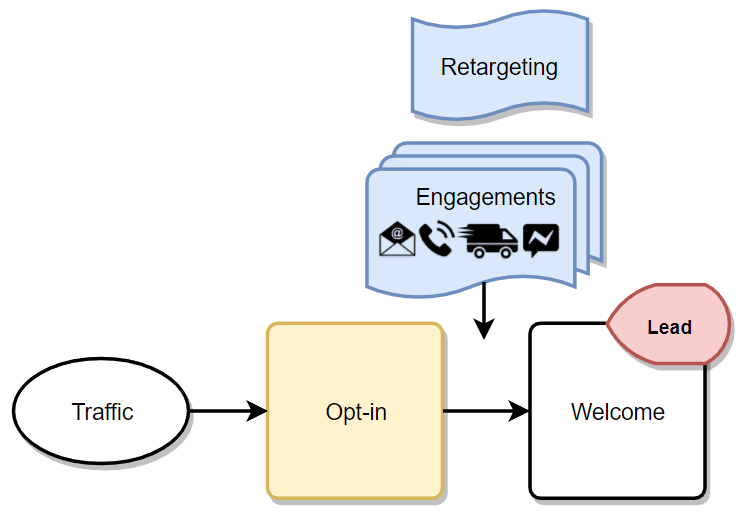
There are times when you might not be trying to sell anything right away…
Like, when you're just getting started… you just want somebody to find your website/business/content.
You want people to know you exist.
A great funnel for this is a 2 Step or Lead Gen funnel.
It works by sending individuals to an opt-in or squeeze page where you capture their contact information in exchange for a Lead Magnet.
A Lead Magnet can be an ebook, checklist, trial, flowchart, mp3, video, voucher, etc… something of value that an individual will happily provide their contact information in order to receive what you're offering.
The “Welcome” page is a page that usually contains a video or brief message that welcomes the individual to your business, tells them to check their email for the Lead Magnet they just requested, and explains how to use the Lead Magnet and/or what the next steps are.
Of course, after the individual gives you their contact information, you will follow up with them through various types of engagements like email, text messages, phone calls, direct mail, Facebook Messenger, and retargeting.
These 2 Step funnels are also great for brick & mortar businesses. You have the individual opt-in for a voucher or discount and then follow up with them to get them into your business to use the voucher/discount they received at opt-in.
- Related Article: What Is A Lead Mangnet & 10 Examples
- Related Article: The 2-Step Lead Gen Funnel For Local Businesses
Sales Page

97% of online transactions look just like the diagram above…
An individual lands on a sales page and they either buy the product or they don't.
Take a look at Amazon… you find the product you want (sales page), add it to your cart, checkout, and receive your order confirmation. That's it.
There are no fancy OTOs, One-Click-Upsells, Downsells, Order Bumps, etc.
This is perfectly fine!
You don't “need” all that fancy stuff.
Setup a sales page, present your offer, and move on to sending traffic to it!
Merge 2 Step/Lead Gen Funnel With Sales Page
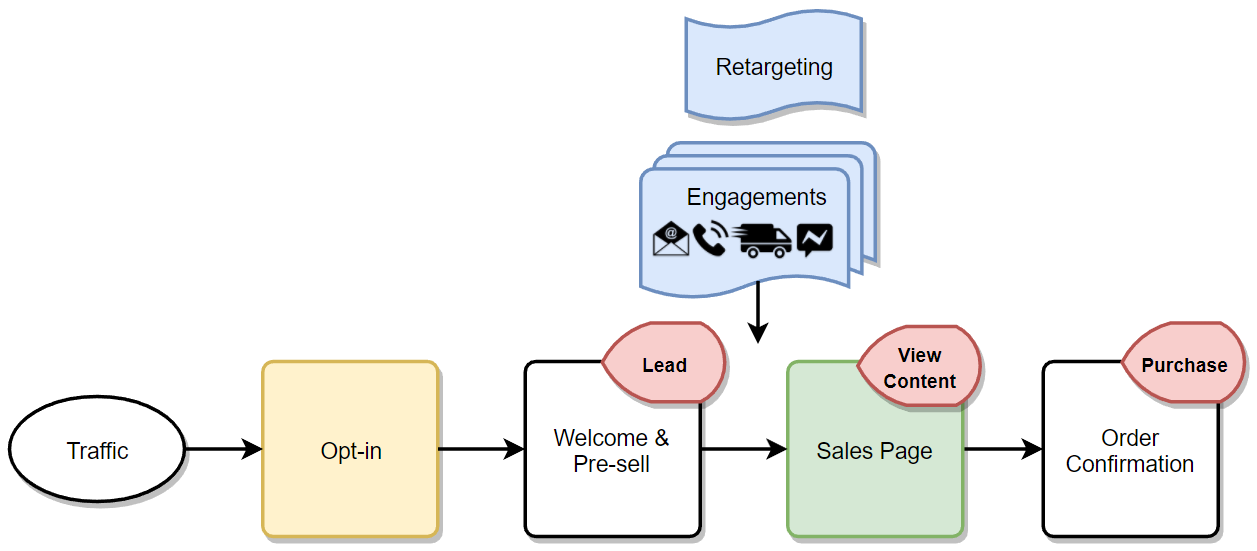
One very popular approach is to merge the 2 Step/Lead Gen Funnel with a Sales Page.
In doing this, you're collecting their contact information prior to trying to sell them a product/service. This allows you to better follow up with them, build rapport, and subsequently increase the conversion rate on the sales page.
If possible, employ this tactic and watch your conversion rates skyrocket!
Front End Funnel
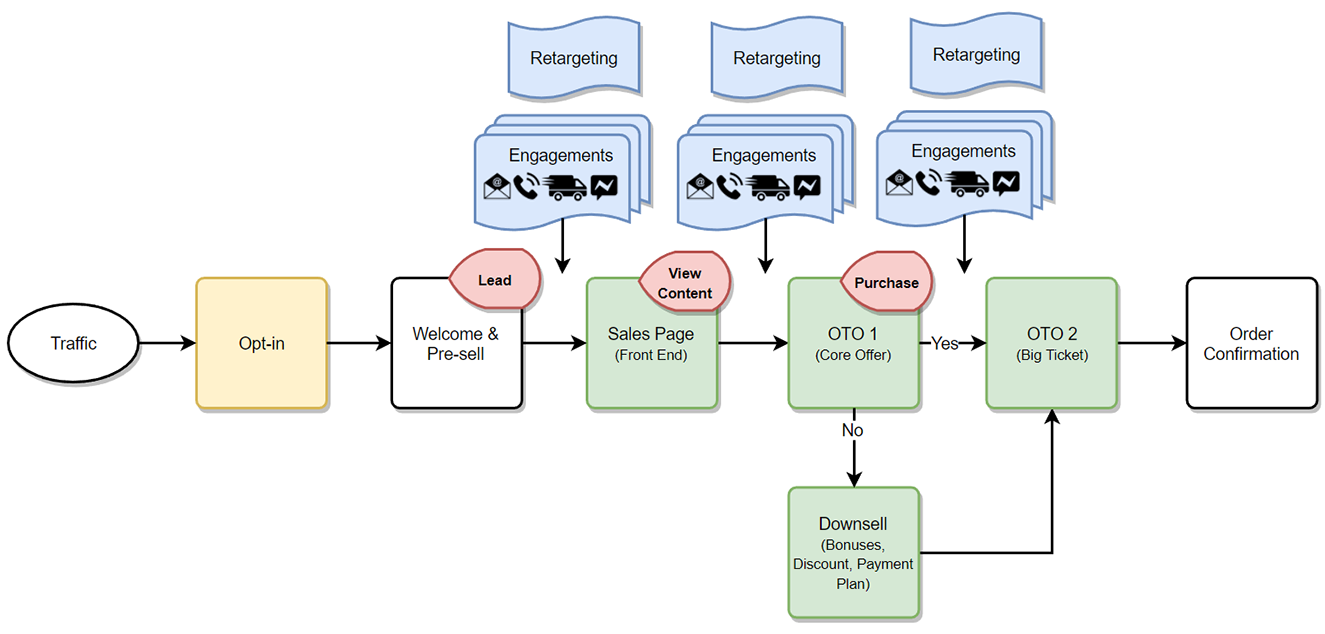
The Front End Funnel goes by many names: Classic Sales Funnel, Trip Wire Funnel, Self Liquidating Funnel, etc. and it's probably the most popular Micro Sales Funnel model.
It can look different from what's illustrated above, depending on what you have/need/etc. For example, maybe you only have one OTO (One-Time-Offer), or maybe you don't want to offer a Downsell, or you don't want to have an Opt-in and Welcome page… that's fine.
The main concept behind this funnel is that you offer something at a very low price (< $10) in order to get the individual to open their wallet. Then, when “the buyer is in heat”, they'll buy until you anger them or stop offering things to buy. (that's the theory, anyway)
So, let's break down the pages:
- Sales Page: Where you offer the very low priced product (< $10)
- OTO 1: This is where you present your Core Offer (the product you really want to sell and why you built the funnel in the first place).
- Downsell: The page an individual views when they turn down OTO 1. Usually, you try to sell your Core Offer again; however, this time incentivize it by including some bonuses, a discount, or a payment plan.
- OTO 2: Whether the individual purchases OTO 1 (your Core Offer) or not, you can show them another offer they might be interested. Often, this is a more expensive product commonly referred to as a “Profit Maximizer”. However, it doesn't have to be more expensive. Use whatever makes sense for your business, customer, and funnel.
Then, throughout the entire funnel, you will continue to “pull” people through by following up via engagements like emails, text messages, phone calls, direct mail, Facebook Messenger, and retargeting.
- Related Article: The AliExpress Sales Funnel
- Related Article: The Amazon Seller's Sales Funnel
- Related Article: The Coaching/Consulting “Book” Sales Funnel
- Related Article: [Case Study] Our Free + Shipping Book Sales Funnel Launch
- Related Article: A Sales Funnel For Selling Digital Products
Webinar Funnel
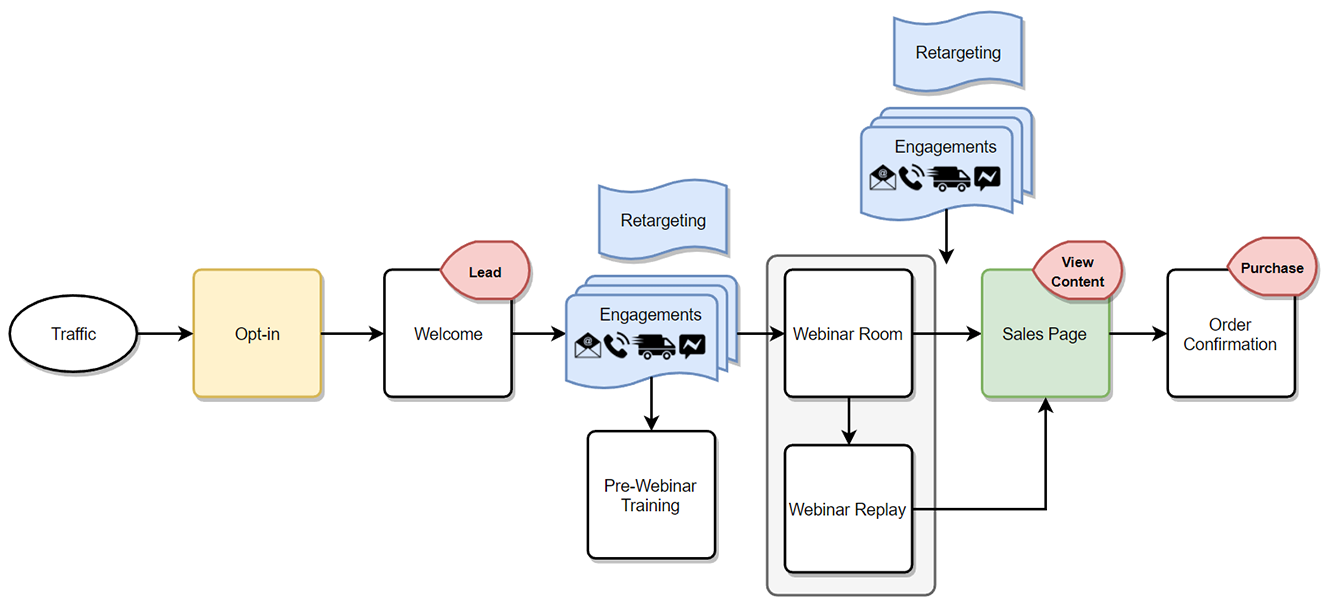
Webinar funnels are quite popular these days because they are often very effective for selling products and services in the $300-$2,500 range.
The particular diagram above illustrates a webinar funnel that has a webinar a few days after someone registers…
How it works – an individual registers for the webinar and then they're dripped a few key pieces of content to get them excited about what's to come. We call this the “Pre-Webinar Training”.
Then, there's the webinar where you teach and then sell…
Then, a replay room for those that miss the webinar or only watch a piece of it…
Then, the Sales Page where you make your last ditch effort to sell your product/service.
Of course, you're following up with emails and retargeting ads (at the very least), and possibly including some text messages, phone calls, direct mail, and/or Facebook Messages (depending on your plan).
One of the best webinar scripts comes from Russell Brunson and his “Perfect Webinar” which can be found here.
Evergreen Webinar Funnel
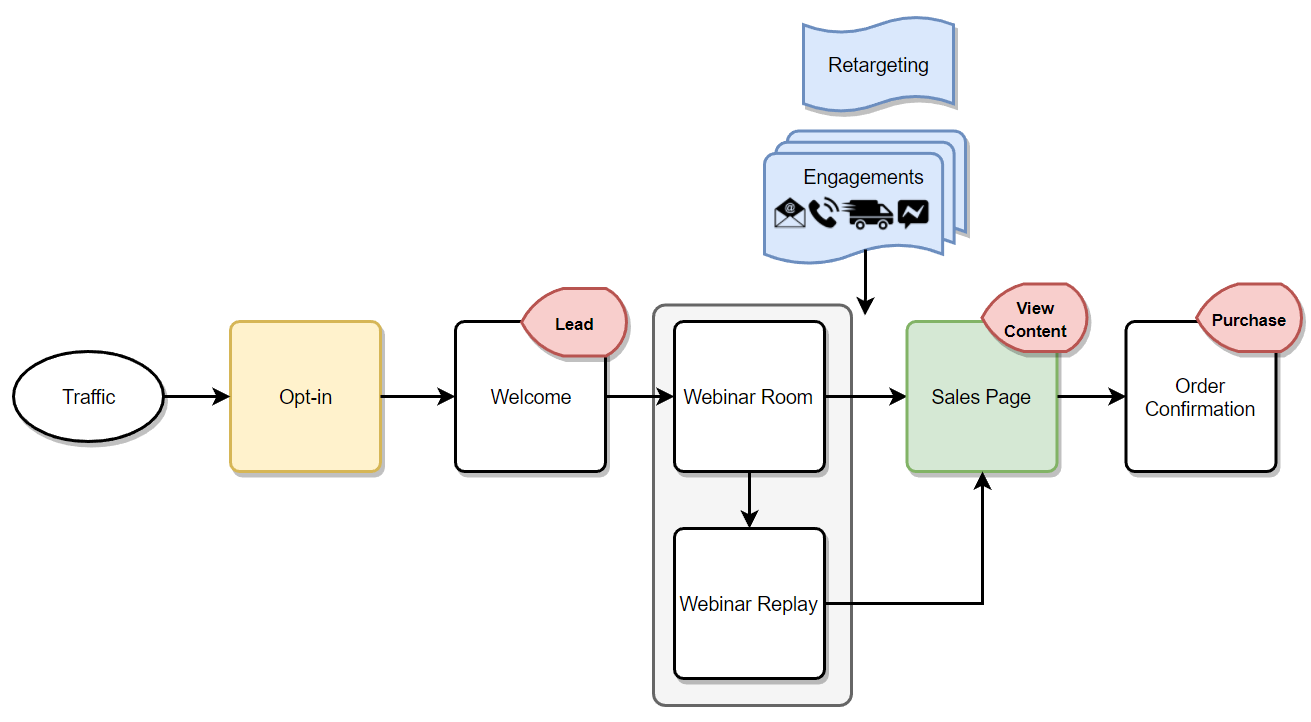
Another way to execute a webinar is via an Evergreen Webinar Funnel.
Ideally, you'll do your webinar live a bunch of times and really nail it down… record it, then turn it evergreen… but, you don't necessarily have to.
The evergreen webinar funnel doesn't usually include the pre-webinar “stuff” and instead goes straight into the presentation.
If you have a webinar already, maybe it's time to turn it evergreen!
- Note: I give you my Evergreen Webinar funnel when you attend my Evergreen Webinar here.
Product Launch Funnel
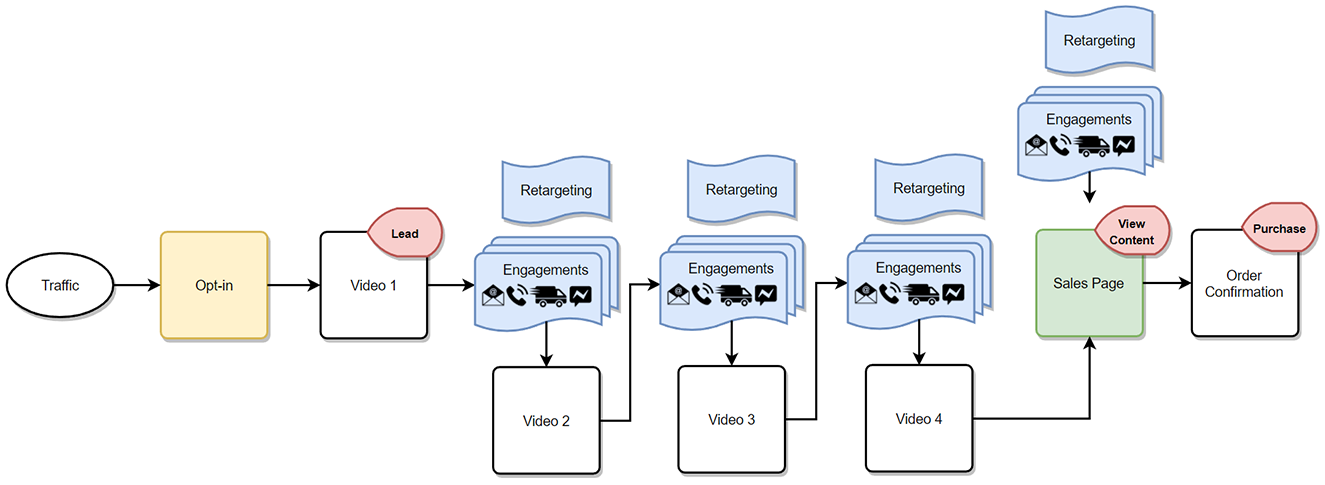
The Product Launch Funnel or “Horizontal Sales Page” has been made popular by Jeff Walker and his “Product Launch Formula.”
It works by having an individual opt-in for training in the form of videos, blog posts, PDFs, etc.
The training is broken down into 4 parts and dripped via email, retargeting, text, etc. to the student over the course of a few days.
In the last training, an offer is pitched to the student for a product/service to take what they learned to the next level.
If you're selling a more expensive product/service, you should pick up the “Launch” book by Jeff Walker because he does a great job outlining the whole concept.
Consultation / Application Funnel
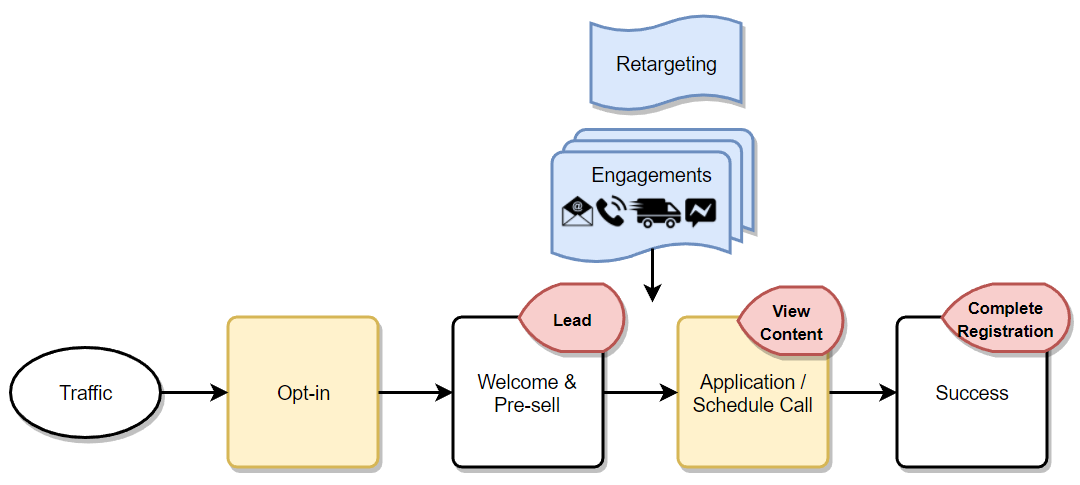
If you're selling a product/service over $2,500, it's typically a good idea to chat with your customer beforehand to ensure they're a good fit.
To do this, you can either offer a “Free Consultation” or make them “Apply” for your offer.
Typically, people you send to this funnel will know who you are and already be intertwined with your business. You probably won't need to have an initial opt-in page for these folks; however, I included it in the illustration above because you may want one in order to capture interest.
On your Welcome & Pre-sell page you will want to include a wall of text and/or video testimonials of individuals that have had success with your offering. Interspersed throughout that page, include links and CTAs to your application form and/or call schedule form.
Finally, on the Success Page, let them know you'll be in touch soon.
The rest of the funnel is “off line” in that you contact them, chat with them, etc. You probably don't need/want to automate this part.
- Related Article: The “Get Clients NOW!” Funnel
Bridge Funnel
Bridge funnels are used to introduce YOUR audience to someone else's offer.
Often, you can't control the other offer's sales page. It says whatever it says and you can't change it.
Now, in order to keep the message congruent so YOUR audience understands what's happening, you will want to use a bridge funnel to “bridge” the gap by connecting YOU to that other offer.
You can also use a bridge funnel to “spruce up” the other offer by incentivizing it with bonuses and other benefits.
Bridge funnels are often used to sell affiliate products or MLM opportunities.
Affiliate Products Funnel
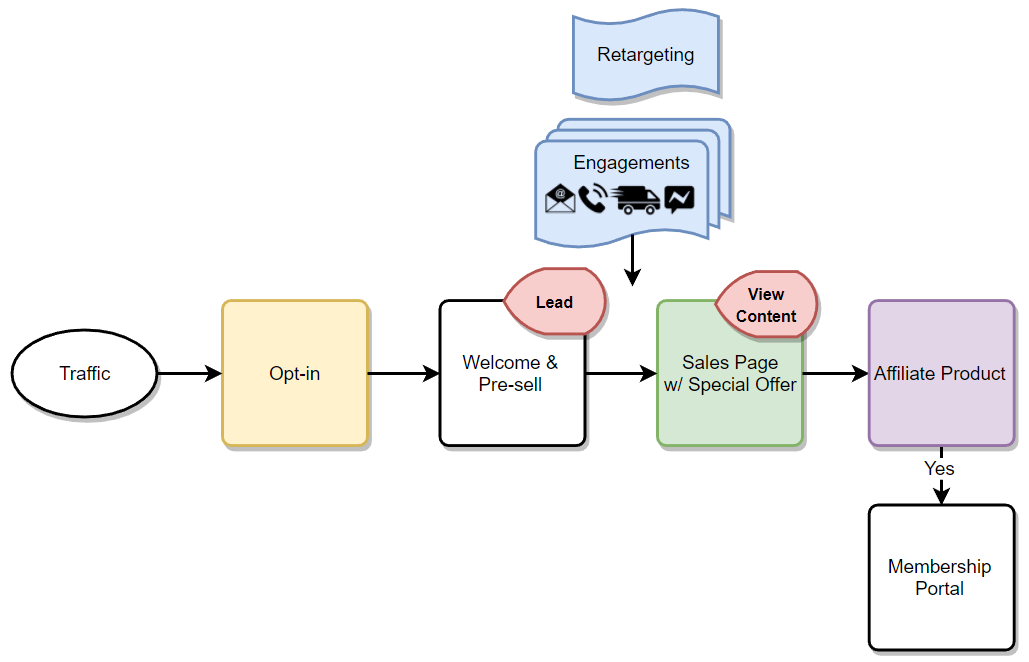
There are times when you might not have your own product or service.
Or, maybe you just want to offer someone else's product for sale because you know it will help your customers.
Whatever the reasoning, there's a funnel for it!
It starts similarly to the other funnels and the Opt-in page isn't “mandatory”, you can direct people straight to the Sales Page w/ Special Offer if you want.
The Sales Page w/ Special Offer promotes the affiliate product you're trying to sell and then offers a bunch of bonuses if they purchase via your link. These bonuses are delivered via a Membership Portal you give the person access to after they purchase the affiliate product.
In the Membership Portal, provide a collection of helpful content like videos, PDFs, etc.
- Related Article: The Affiliate Marketing Funnel
MLM Funnel
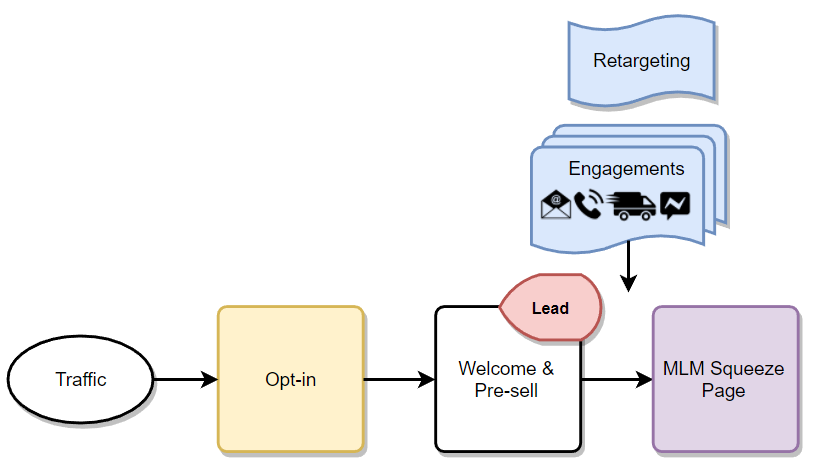
Most MLM (Multi-Level Marketing) networks are BIG on digital “stuff”.
When you join, they'll hook you up with squeeze pages, landing pages, full websites, etc. and tell you to post messages on Facebook to get everyone you know to those pages they setup for you.
Sending people to the MLM's squeeze pages can work fine; however, you can take it one step further by creating a special Bridge Funnel to “bridge” the gap between you, your audience, and the MLM network. You can use a Bridge Funnel to share your story, share your downlines' and/or upline's stories.
This will allow you to better connect and sell the MLM opportunity.
The actual design of a MLM Funnel can look like the diagram above where you have people opt-in to see your Welcome & Pre-sell page, or you can remove the opt-in page and just send people straight to the Welcome & Pre-sell page.
You could even make a funnel similar to the Affiliate Product Funnel and incentivize the joining of the MLM network.
There are many ways you can do it. Just remember, the point is to bridge the gap between YOUR audience and the MLM network!
Merging Sales Funnels
All of the funnel illustrations above are just examples…
Depending on your needs, wants, and desires… your funnel make look different…
And, that's A OK!
My point in this post is to get you started in the right direction.
With that said, you can certainly “merge” funnels together much like the 2 Step/Lead Gen Funnel being merged with the Sales Page up above…
And, if you didn't notice… the “Sales Page” is the start of the Front End funnel too… it's just the next page is different.
So, you may combine a Webinar or Product Launch funnel with a Front End/Classic sales funnel:
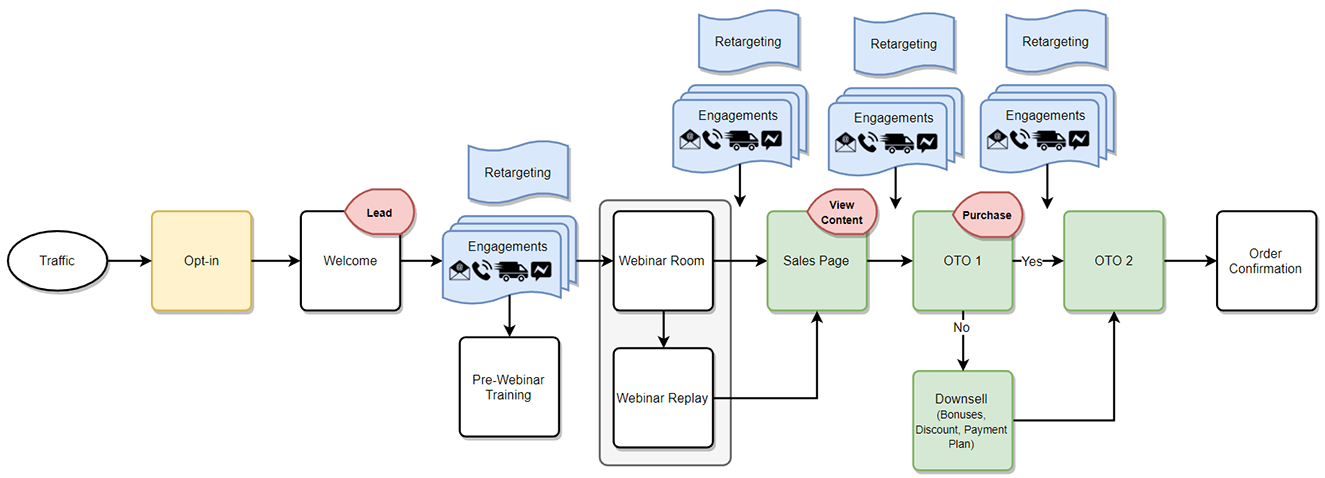
Sure, in the above example, the Initial Offer isn't some cheap product; however, you could still offer an OTO or two like advanced training, coaching, and/or consulting.
Your “funnel” doesn't have to be “literal”. (hopefully that make some sense! All I'm saying is, do what makes sense! This stuff is flexible!!!)
Stacking Funnels
If you followed the flowchart at the very top, I mentioned “Funnel Stacking”.
Basically, that is simply…
Taking people through a natural progression… ie. your Value Ladder.
Who buys your ultra-premium product/service?
Brand new people who just came in off the street? Or, people that purchased a few lower to mid-range products/services first?
My guess is, it's usually people that have purchased some of your other offerings first.
People need to get a “feel” for who you are and what you offer before they whip out their credit card to buy your $10,000 package.
Makes sense, right?
It's a natural progression.
One of my clients is an anti-aging specialist…
I built a “Front End Funnel” for him that sells his book and some of his digital training resources…
We break even on the front end. (his ad spend is covered)
On the back end, his schedule is booked solid the next 3 months for EXPENSIVE services.
So, he's getting people to know who he is for “free” and then, once they're “in”, he sells them on his other services…
That's how it's done!
Remember the Macro Sales Funnel I spoke about at the very beginning? “Bring people in and see what they're interested in” … that's the strategy!
Launch your Lead Gen funnel or Front End Funnel, then guide people to your Webinar or Product Launch funnel, and then guide them up to your Consultation or Application Funnel!
Note: These funnels aren't back-to-back-to-back like when you merge funnels. There may be months or even years in-between purchases.
Will A Sales Funnel Work For My Business?
If you made it this far, you can probably answer this question already.
Basically, if you have something to offer to an individual, whether it's a product, service, or opportunity…
Whether it's digital, physical, or something in-between…
Having a funnel in place will help your business.
After all, it's just a few pages and some engagements… it's nothing super special, mysterious, or magical.
It's you, engaging with your prospective customer and trying to get them to like you and/or your offer enough to buy it.
That's it.
So, hopefully that answers that question!
Final Thoughts
This post primarily covered Micro Sales Funnels, but I don't want you to forget the big picture and the Macro level sales funnel that contains these Micro sales funnels.
Without understanding the big, Macro picture… your Micro sales funnels will suffer.
I also want to point out that Micro sales funnels are just a couple of pages and engagements (emails, retargeting ads, text messages, etc.)… that's it. It's not some crazy hack or tactic. It's like any other website on the Internet, it's just done with strategy, purpose, and intent with the goal to sell your offer.
Finally, if you want to learn more, I recommend you check out the Sales Funnel Training Vault!

